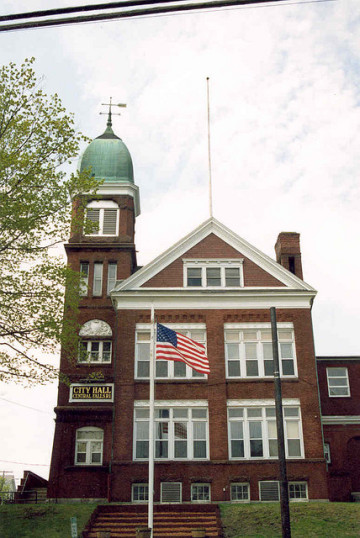Five cities and towns depend on state aid for about a third of their spending, according to a GoLocalProv analysis of local and state documents.
Those communities are in order: Woonsocket, Pawtucket, Warren, Providence, and Burrillville.
Of course, that’s not counting Central Falls, where the state has been funding most of the school district long before the city went bankrupt. As of 2014, the year for which most recent statewide figures were available, the state paid for 71.7 percent of local spending in Central Falls.
A breakdown for all 39 cities and towns is listed in the below slides.
Most of state aid is for education. But municipal aid was included and weighed against all local spending too to get a sense of the whole picture. After Central Falls, was Woonsocket, which up until recently had its finances under the control of state authorities and counted on state aid for 37.3 percent of its budget in 2014.
‘Municipal finance is broken’
One policy expert said the list indicates that municipal finances were in shambles.
“Municipal finance is broken,” said Sam Bell, the state coordinator for the Progressive Democrats of America.
“There’s a wide variation in the wealth of various cities and towns. This puts poor cities and towns in a vice. For a city grappling with poverty, the costs are huge. More must be spent on police, fire, education, and general services, yet far less money is available to spend. Policymakers cope the only way they can—by raising property taxes sky high. But high property taxes exact a very real burden on working families and small businesses. The only way out of this trap is for the state to step in to keep poor citiesand towns from going bankrupt. But state aid is far too stingy,” Bell said.
Some communities are still feeling the sting from cuts to state aid made under former Gov. Don Carcieri. Those cuts have been blamed in the past for some of the financial struggles of communities like Providence and Woonsocket.
But Gary Sasse, who served as administration and revenue director under Carcieri, said the state had little choice. “During the recession there was no option,” Sasse said. He ticked off the non-options: raising taxes, breaking union contracts, and cutting Medicaid, one of the largest areas of spending but off-bounds from cuts due to federal restrictions.
“I think those cuts, given the circumstances, were unavoidable,” Sasse said.
Sasse, now the founding director of the Hassenfeld Institute for Public Leadership at Bryant University, also noted that the Carcieri administration had pushed for a legislative package that would have allowed cities and towns flexibility to absorb the cuts.
Sasse maintains the current system of aid is working, since the neediest communities—such as Woonsocket and Pawtucket—are receiving more state aid. But he said the system can still be improved, especially by alleviating the burden of the car tax.

Capital city one of most dependent
Providence ranked as the fifth most state-dependent, with 33.15 percent of local spending being funded through state coffers.
“Making this problem worse, our central city is one of our poorest. Providence’s median income is slightly below Mississippi’s, and Mississippi is the poorest state in America,” Bell said.
Providence received about a quarter of a billion dollars in total staid in 2014. Slightly over half of what it spent on education—$402.5 million—was state money.
As the largest city and the largest school district, it should be no surprise that Providence receives the most. But there’s a downside to that that arises when cuts in state aid are made, according to Luis Aponte, the president of the Providence City Council. “In the same vein, Providence gets the hardest hit,” he said.
But take out the $206.8 million it receives in education aid and one gains a better sense of how much it’s really getting from the state, according to Aponte.

Aponte said the city needs more PILOT aid from the state. (PILOT stands for Payment in Lieu of Taxes, to cover the taxes that would be paid by nonprofits.) As nonprofit hospitals and universities continue to expand, the tax base in Providence continues to shrink. Meanwhile, state revenues from income taxes increase as those nonprofits add jobs, Aponte said. As a result, state aid needs to be re-balanced, he concluded.
Is the state ‘redistributing’ wealth?
But some worry that the state may be tending too far towards redistribution of wealth.
“It’s clear that some interests want state tax-and-spend policies essentially to be redistributive, to make wealthier people in the suburbs pay for the local services of the cities. The telling thing is that the difference comes largely from education, which is a good marker of the success of teachers’ unions in moving their interests out of the hands of local voters into the hands of the Statehouse, where the central organization of a labor union can influence policies in a way that unorganized taxpayers cannot counter,” said Justin Katz, the research director for the Rhode Island Center for Freedom and Prosperity.
But increasing state funding for Providence would not necessarily be redistributive, according to Aponte and Bell.
As the state center for commerce, education, and recreation, all residents benefit from what Providence offers, Aponte noted. That’s especially the case for the nonprofit hospitals, which serve a statewide population, and the nonprofit colleges and universities, which also benefit the entire state, according to Aponte.
“If Providence were able to tax the income of wealthy commuters who live in the suburbs, we could eliminate or drastically reduce property taxes and solve Providence’s fiscal nightmare overnight. This is the policy solution many other states take to this challenge, but the General Assembly will not allow Providence to implement it. And so our central city crumbles—plagued by poverty, a shrunken police and fire force, struggling schools, brutally high taxes, and fundamentally impossible math,” Bell added.

To some it makes sense that the most financially distressed communities get the most in state aid. But Chartier wonders if state aid might actually be hurting rather than helping them.
“It’s impossible not to question whether state aid enables, to a certain extent, bad budgeting practices on the local level. Are local officials shielded from making tough spending decisions because of this money that painlessly ‘falls out of the sky’ (a.k.a., from the state coffers) and into local budgets?” Chartier wrote in an e-mail.
Chartier offered the examples of local firefighter overtime and teacher pay.
The question is particularly acute in Woonsocket where one city councilman told GoLocalProv that the city was tasked with absorbing a $17 million reduction in state aid. City authorities tried and could not make the cuts said Councilman Roger Jalette. That led to the state-appointed budget commission taking control of city finances.
The state just relinquished control earlier this year, leaving city leaders with “manageable” books. But they also left something else: a community in which a lot of people could no longer afford to live because of high property taxes. Some had to sell their homes. Others had to seek housing aid, further exacerbating the problem of how to raise enough funds for public services, according to Jalette.
In Jalette’s view, it’s not city authorities, but some in the local population that are dependent on government assistance. The city needs more middle-income residents and people with disposable income. Instead, it’s attracting a different population: “We’re gaining people who enjoy the luxuries of freebies,” Jalette said.
He said public housing projects are putting an especially heavy burden on local services. “The cost of schooling children from these housing projects is astronomical,” Jalette said.
And, the state aid meant to cover those costs isn’t, he added. “The fair funding formula turned out to be not as fair as it was supposed to be,” he said.
That formula is being changed and Woonsocket is once again due for more state aid, but in the meantime it still must shoulder the costs of educating students today, Jalette said.
Source and Photos from GOLOCAL/Prov

No comments:
Post a Comment